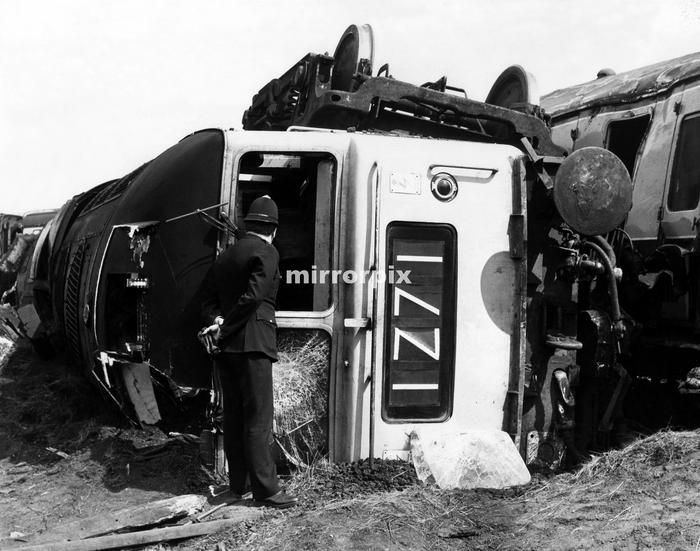Time 21:35 Country England Total number of deaths 6 Rail line Bexleyheath Line | Location Eltham Well Hall Date 11 June 1972 Injuries 126 Trains 1 | |
 | ||
Cause Driver error (due to intoxication) Passengers 10 'well filled' coaches Similar Ilford rail crash, Ealing rail crash, Wembley Central rail crash, Cannon Street station rai, Spa Road Junction rail crash | ||
The Eltham Well Hall rail crash was an accident on the British railway system that occurred on 11 June 1972 at approximately 21:35.
Contents
An excursion train from Margate to Kentish Town derailed on a sharp curve at Eltham Well Hall station, Eltham, London. The driver Robert Wilsdon and five passengers were killed, and 126 people were injured. At the subsequent public inquiry it was revealed that the driver had been intoxicated by alcohol.
Background
The train was an excursion for Kentish Town-based railway employees of the London Midland Region and their families. After arrival at Margate, the train was stabled at Ramsgate. Wilsdon was not due to be on duty until the afternoon and had gone to a pub at lunchtime with his brothers who said he spent the afternoon at home.
At about 15:20 he booked on duty by telephone with Hither Green depot and travelled by train to Ramsgate. Wilsdon met with his secondman, a youth of 18 years, there. They prepared the train which consisted of a Class 47 diesel locomotive and 10 coaches. While they chatted the secondman 'smelt something pretty strong' on the driver's breath and when questioned about it, he replied that he had "had some beer at dinner time" and had "ended up going somewhere and drinking some sherry".
Nevertheless, at Wilsdon's suggestion, they both went to the nearby Railway Staff Association Club at about 19:00 and drank three pints of light and bitter beer each. At 19:45 they met with the guard and drove the train to Margate to receive the passengers.
The journey
The crew left the cab for a few minutes and as a result the train departed from Margate eight minutes late. The journey was normal until the train stopped for signals at Rainham, whereafter the driver made an unscheduled stop in the station to telephone the signalman and ask about another excursion train that they were due to pass some distance ahead. This was a very unusual action, particularly as he had made up almost seven minutes of the lost time.
The guard told the inquiry that after leaving Rainham he had noticed that the train's speed has been "a little bit excessive" and that the driver braked intensely between Gillingham and Chatham. Approaching Eltham Park he became so concerned at the speed that he made two quick applications of the vacuum brake to try to draw the driver's attention, but before he could get a reaction it was too late.
The accident
The curve at Eltham has a speed limit of 20 miles per hour (32 km/h), but according to eyewitness accounts, the train entered it whilst travelling at about 65 miles per hour (105 km/h). Computations later proved that the driver had apparently shut off power where required, but had not made a brake application.
The locomotive and first four coaches left the rails and came to rest at an angle to the track, the second and third coaches on their sides. The next five coaches were derailed but the 10th, in which the guard was riding, was not.
The actor Phil Daniels, star of Quadrophenia, Scum, and later EastEnders was aboard one of the derailed coaches with his parents after a day trip.
Investigation
All witnesses who saw the driver including the guard, the station staff at both Rainham and Margate, and the depot staff at Ramsgate, observed no signs of intoxication. His speech was clear and his gait was normal. Those who knew the driver said that he was quite a frequent drinker of alcohol and could "carry" much beer.
A post-mortem examination of Wilsdon showed that he had a blood alcohol level of 0.278% (the legal limit for driving a road vehicle in England at that time was 0.08%). There was an imbalance with the urine alcohol level which made it very likely that the driver had also been drinking alcohol at the controls. Two bottles of beer given to the crew by the excursion's organisers were found in the cab, but they were unopened. A medical expert stated that during the time given, 5½ pints of bitter, a third of a bottle of sherry and a quarter bottle of spirits would "just about achieve" the levels found, providing that "the bulk of the spirits was drunk between 20:15 and 21:30". The inquiry hypothesized that the driver had taken spirits into the cab with him, having collected them during his unexplained absence before leaving Margate.
The secondman may not have been attentive because he had also been drinking, but he did not know the route and would not have realised that the driver was not braking for the curve when he should have been.
Recommendations
The Inspecting Officer, Colonel J.R.H. Robertson, concluded that the driver Robert Wilsdon had "grossly impaired his ability to drive safely by drinking a considerable quantity of alcohol both before and after booking on duty, including some shortly before leaving Margate and some more in his cab during the journey."
He made recommendations that booking-on of drivers by telephone should be controlled carefully, but did not recommend any changes to warnings of permanent speed restrictions. However, changes were made to the signalling at Eltham so that through trains would receive a yellow signal on approach.
The recommendation that booking-on by telephone be carefully controlled was reiterated in the Inspectorate report of the Cannon Street Station rail crash in 1991.
